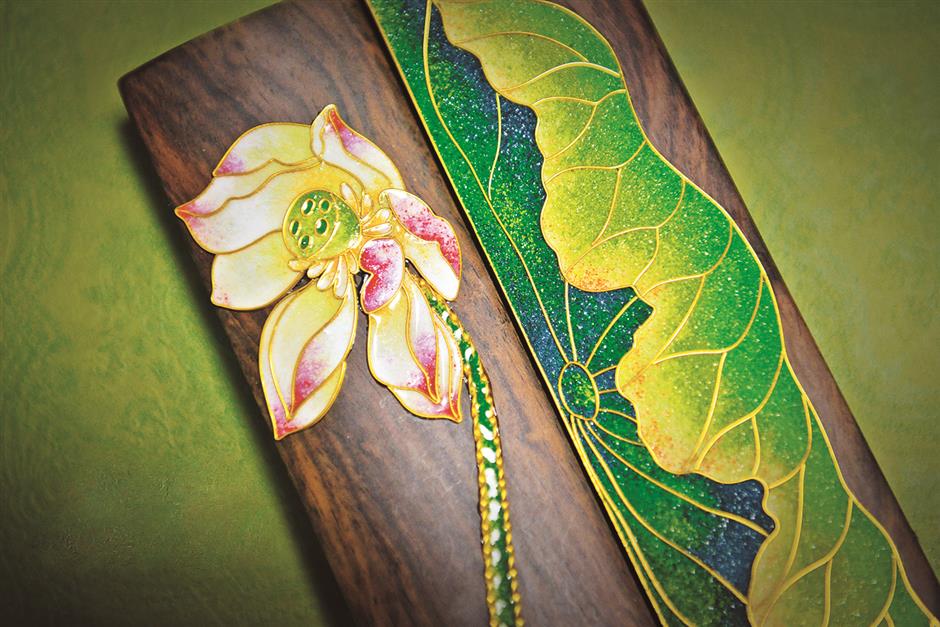Artist revives wiry enamel with stunning creations
Edited by Yang Yang. Reported by Yang Yang. Subtitles by Yang Yang, Tracie Barrett.

Dong Hui works on a wiry enamel work at her studio in Wujing.
The first time Dong Hui, a young artist of the Minhang District Folk Arts and Crafts Association, experienced the allure of wiry enamel was at its low end – a color-sand picture at a primary school craft class taught by her friend.
"They used color sands to replace enamel glaze due to limited budget," Dong said.
"The children's works were unadorned, but the craft nonetheless appealed to me. Later I had a chance to appreciate real wiry enamel artworks, and thought, 'That is what I will pursue'."
Wiry enamel is a branch of the ancient cloisonne enamel. Cloisonne enamel, according to historic findings in the 1980s, was introduced to China during the Yuan Dynasty (1271-1368) from Arabian countries.

An enamel work with dragon and phoenix pattern
Origin of jingtai lan
It reached a development peak during the Jingtai Period (1450-1457) in the Ming Dynasty (1368-1644), and frequently used blue as its major color, hence its name jingtai lan (景泰蓝). The craft was at first a pursuit of royal craftsmen to make delicate utensils for imperial households, and later it spread into the folk society.
Its procedures involve making the mold, pinching and attaching wires on a workpiece, infusing enamels into slots with a paint gun or a dropper, kilning, polishing and gilding.
In wiry enamel, procedures are simplified, to include pinching and attaching wires, infusing enamels and cementing glues.
The enamels, frequently using mineral stones like quartz, feldspar and fluorite as major components, also add borax powder to assist melting and several noble-metal oxides as colorants.
Normally enamels of the same mesh size will be used together in a color scheme. Warm and cold colors will be coordinated, the entire color scheme will reflect the space hierarchy and usually eight or 10 colors will be adopted to express a gradient.
Dong tried all means to learn the craft in Shanghai and later set out to Jinan, capital city of Shandong Province, to learn from an intangible culture inheritor.
"My master, who is also a national gift maker, gave me dozens of tips on doing wiry enamel, which otherwise I would have needed years to figure out," Dong, who has just returned from a recent trip, recalled.
"I used to try to enamel on a gourd and had trouble because the surface was a curve rather than a flat," she added. "My master explained and it dawned on me that I could have attached the enamel bit by bit like on sequential tangent planes on that curving surface.

A red piano featuring Dong Hui's enamel creation became a highlight at the Shanghaiskills 2023. In this artwork, Dong reproduced a heavy-color painting work by the renowned artist Li Shoubai, depicting the landmark architectures of Shanghai.
Incessant pursuit of excellence
"And I learned a diverse category of glues ranging from crystal glue, filmic adhesive and polymer stabilizer, among others, in my study in Jinan. Some are used to cement enamels on a flat surface and some on a three-dimensional surface. One glue might be a total alternative to the other."
After fully mastering the craft, Dong returned to her hometown Wujing of Minhang District and set up her own studio at its culture and sports center.
Wires, like spider's threads, pour out through her fingers to form the glittering frames, the slots of which were later filled with diverse colors of enamels.
In the recent Shanghaiskills 2023 from April to May, a red piano with enamel patterns was a highlight.
It was a cooperative work by Dong and Chinese heavy color painting artist Li Shoubai.

Dong Hui's lotus-themed work, a creation inspired by Lianhua Road S. in her hometown.
Dong reproduced Li's heavy color painting work portraying Shanghai-style shikumen (stone-gate) buildings, the zigzag bridge of the Yuyuan Garden, the Lujiazui high-rises, China Art Palace, Shanghai Science and Technology Museum, Oriental Sports Center, Lingang New Area and other landmark architectures in Shanghai.
In the 2023 Shanghai Citizens Art Festival, Dong was selected as its "Most Beautiful Craftsman" in its Yangtze River Delta Citizens' Handcraft Competition.
In addition, she is also trying to apply cultural elements of Wujing to her wiry enamel works, including lotus themed works inspired from Lianhua Road S. and a recreation of carvings on a slate of the historic Shangyi Bridge of the town.
"It will be such an accomplishment if my works with Wujing cultural traces can strike a chord among the folks of my hometown, meanwhile the craft itself will be promoted in the area," said Dong.
















